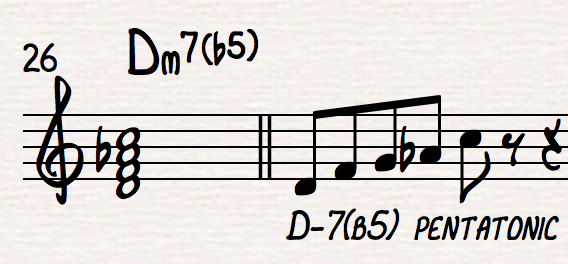When I was first exposed to the half-diminished chord, I was told to simply play the major scale a half-step up, thus giving me the proper chord-scale relationship. After giving a number of other approaches a shot in between with mixed success…
I’ve started thinking about the half-diminished chord in a new way that really opened up my playing: think about simply playing the dorian minor starting on the third of the root
(i.e. for Emin7b5, play your G-dorian). You will give weight to the proper chord tones and start feeling more free over this complex-sounding harmony. More explanation down below.
Hold Up, What’s a Half Diminished?
Don’t feel bad if you have no clue what I’m talking about. In traditional jazz harmony, minor and major tonalities are tonicised (made sound like the key / landing point) with specific cadences (one or two chords that lead to the root). Take C-major. The standard cadence leading to it is a ii-V7-I (Dmin – G7 – Cmaj), where you can just move up and down the white keys to find the different modes of the major scale that fit each chord.

In minor keys, it’s a bit more tricky. The ii-chord, specifically, functions as a ii7(b5) – our half-diminished chord, since the flat fifth degree starts to have “pull” (harmonic tension) leading you a half step down, to the root of the dominant chord, also the fifth degree of the minor scale. It’s called half diminished because the fifth is flat, rather than natural, but the seventh degree is the same as the seventh degree of a minor seventh chord (lowered). A fully diminished chord would have minor third intervals all the way up.
Let’s take an example. In the key of C-minor, the ii-chord is a Dmin7(b5) (half diminished). The arpeggio is D -F – Ab – C. Fully diminished would have a Cb (B). If you’re confused, go over to a piano and play Ddim7 v. Dmin7(b5), since, as with all music, it’s much easier to hear it than just read and get it.

Major a 1/2 Step Up – Not the Best
I began by mentioning the traditional approach to teaching the half-diminished chord – play the major scale a half step up, i.e. Ebmaj over Dmin7(b5). This will technically work, since the Eb major scale has D, F, Ab, and C – all the chord tones. HOWEVER, you aren’t really getting inside the harmony by playing this since you’ll probably give more weight to non-chord tones, which arpeggiate Ebmaj (Eb – G – Bb), and give less weight to the all-important chord tones (D – F – Ab – C). Therefore you aren’t outlining the harmony, and while playing major-sounding lines (Ebmaj7 over a Dmin7b5) is sort of hip, that’s running before you can walk and is not true to the traditional jazz language. You’re basically speaking only in metaphor without knowing how to construct a proper sentence.

Dorian off the Minor Third – Why it’s Better.
As I noted up top, I’ve started to play off the dorian minor starting from the third degree of the half-diminished. You’ll notice this is exactly the same scale, just starting from a different note. But the huge difference here is the notes in blue from the picture above. By simply thinking of it as a dorian minor rather than major chord, your lines will find the chord tones rather than passing tones.
Alternative Approaches to the Half-Diminished
I’ve presented two ways of thinking about playing over a half-diminished tonality, but don’t limit yourself to those options. Here are other common ways we can frame this tonality in the form of other chord-scale relationships:
- Melodic minor up a minor third: Very similar to my dorian from the third approach, by simply raising the ninth degree of the half-diminished chord but using the “up a minor third” approach above, you can play the melodic minor scale instead of dorian. Some find this hipper, but really, you can listen to whoever is comping behind you to determine whether a natural or flat 9th is more appropriate. Or you can dictate it yourself.

- Half-Whole or Whole-Half Diminished Scale: They both work, technically. Many players will use the whole-half, then keep that going over the full minor ii-V7 (notice it also works perfectly over the five chord, containing all the chord tones up to the flat-ninth of G, B, D, F, and Ab).
- Minor 7 b5 Pentatonic: In more of a modal context I’ll utilize the pentatonic approach for a more angular sound. Playing over Inner Urge is a great example of non-functional, modal usage of the half-diminished chord. Here’s just a minor pentatonic with a flat 5.

What approach do you use? @TWoodshed with your thoughts!
Currently listening to Walter Smith III – III.
